It’s no secret that job seekers can feel frustrated with recruiters.
Why are they slow to respond? What happens to my resume after I submit an application? Are they really on my side?
I’ve heard this even more over recent years with the pandemic and Great Recession making hiring even more turbulent.
I’m here to pull back the curtain and give you the inside information from a real-life corporate recruiter who is on the front lines of hiring during 2022’s historic job market.
Meet Maggie Keuper, an internal recruiter for K12 Insight, an education technology company. She handles company-wide hiring—that’s everything from entry-level to director-level, for roles in sales, marketing, client success, product, and more.
Read on to learn more about Maggie’s priorities and processes for hiring, and how to use that information to make your own job application a success.
What an internal corporate recruiter does (and doesn’t do)
Here’s the first thing you need to know about Maggie. She cares about her work. She cares about her company and about the people who apply to work for them. But bottom line, Maggie’s job is to contribute to her company’s success and profitability.
She does this by keeping roles filled so company operations can run smoothly. She coordinates with team leads, executives, and other stakeholders to reach hiring decisions. She works to make the application and hiring process smooth for candidates—but she does that within the context of the company and its needs.
This is in contrast to an external recruiter or agency recruiter. External recruiters maintain a larger pool of candidates because if a candidate is not a good fit for Company A, they may well be a perfect fit for Company B.
Here’s what Maggie’s day-to-day work schedule includes:
- Screening new applications.
- Reaching out to potential candidates on LinkedIn.
- Following up with existing applicants.
- Finding ways to streamline the hiring process.
- Coordinating interviews and meeting schedules with upper management to keep the hiring process moving forward.
- Conducting interviews– as many as eight per day!
Extending job offers and onboarding new hires.
The takeaway for job seekers: Understand that a single recruiter is juggling numerous moving parts. Do your part to follow up and communicate clearly.
How corporate recruiters use LinkedIn
Maggie says LinkedIn is her go-to platform for recruiting passive candidates (candidates who are not actively job seeking).
LinkedIn is especially helpful in recruiting professional roles in sales, marketing, client success, human resources, and business operations.
However, candidates for skilled labor roles such as truck driving, construction, and maintenance are more likely to be sourced through Indeed, Craigslist, and Monster. If you’re targeting a role in one of these industries, Maggie recommends uploading a current resume to the sites’ job boards.
Maggie sources candidates on LinkedIn by using three main search filters:
- Job Titles and Industry. She starts by searching for candidates who have or who have had similar job titles as the title of the role she is recruiting. She also filters by industry if the role requires direct experience in a certain field.
- Skills and Keywords. Next, she searches for candidates whose resumes or profiles contain the key skills listed in the job description’s requirements. She cautions job seekers to avoid company-specific jargon that won’t translate to recruiter keyword searches.
- Access. Recruiters can only see what you allow them to see. Maggie recommends that if you are actively seeking new opportunities, review your LinkedIn account’s privacy settings. Accounts that allow relevant access enable her to view information pertinent to her search. This helps her to not overlook good-fit candidates who otherwise may not appear if their privacy settings are highly restrictive.
For more information on optimizing your LinkedIn profile to attract the right recruiters, see here.
Maggie offers an important reminder for job seekers using LinkedIn:
Every company and each recruiter follow slightly different hiring processes and recruitment practices. As an internal company recruiter, Maggie recommends you always apply for a position directly through a company’s website rather than a third-party site like LinkedIn or Indeed.
Even if you find the job via a job board, submit your application on the company’s internal site. This helps ensure that the recruiter sees your application and that your application syncs with their ATS system. For more on how HR software screeners work, see here.
The takeaway for job seekers: Imagine the search terms the recruiter hiring for your target job might use. Update your LinkedIn profile to contain those keywords. Check your profile’s privacy and location settings.
How the corporate hiring process works
If you’ve ever wondered what exactly happens once you submit a job application, here’s Maggie’s quick rundown of her hiring process:
- Receive an application submitted through K12 Insight’s career page, or she contacts professionals on LinkedIn to request a resume.
- Do a quick resume screening. Just a minute or two scanning job titles and responsibilities. For more on how a recruiter reads a resume, see here.
- Conduct a phone screen. This is a 20-30 minute interview covering the applicant’s employment history, why they left their past job, and whether they have the necessary qualifications.
- Assessments. Maggie often assigns assessments to gauge a job applicant’s critical thinking and problem-solving skills. The results are a data point she uses in conjunction with the phone screen to evaluate the candidate.
- Schedule further leadership interviews with hiring managers and executive teams. At K12 Insight, a meeting with the company founder and CEO marks the final step in the interview process.
- Job offer and background check. As soon as all members of the hiring team give the green light, Maggie contacts the candidate to issue a job offer. At the same time, she initiates a background check and employment verification. Job offers are contingent based on the results.
Once you’ve applied, Maggie recommends following up with the recruiter on LinkedIn. Recruiters are looking for candidates who are proactive, take initiative, and are appreciative of everyone’s time. Reaching out to the company recruiter shows that you fit the bill.
When you contact a recruiter on LinkedIn, Maggie recommends personalizing your message. Messages that stand out are ones that demonstrate your research into a company and showcase your personality!
The takeaway for job seekers: At any one time, corporate recruiters are managing a complex, multi-phase process for multiple candidates. Show your stellar professionalism from the get-go by being responsive, accommodating, and clear throughout every step of the process.
What a corporate recruiter is looking for in a resume
Maggie recommends sticking to time-tested resume best practices. She prefers resumes that have a straightforward, simple format and highlights a candidate’s work experience in reverse chronological order with clear dates, job titles, and impacts that are quantified.
Using the traditional resume format can be a service to the recruiter because it enables them to navigate your data more quickly.
Here are some pointers to keep in mind as you draft your resume:
- Make sure your resume’s Summary section is tailored to the position you are applying for.
- Use data. Don’t just say “top sales rep.” Provide actual quota attainment and percentages to quantify your impact.
- Make sure to translate company-specific language into industry-standard keywords and metrics. For example, listing that you received a “Catalyst Award” is much less compelling than specifying “performance award for top 10%.”
- Customize the resume. Maggie says, “I know it takes time to tailor bullets for a specific position. If you are really passionate about the position and really interested, take the extra 20-30 minutes to tailor bullet points and highlight experiences that pertain to the job you’re applying for.” Maggie recommends saving a master copy of your resume and creating variations with specific keywords for each job application.
The takeaway for job seekers: If a job is worth applying for (and potentially dedicating 40+ hours of your life to each week for years to come), it’s worth doing it right. Upword Resume’s Customization Guide walks you through this process of adapting your resume.
For more tips on how to tweak your resume for specific job applications, see here and here.
Thanks to Maggie and the K12 Insight team for generously sharing this information.
I swear I didn’t prime her. But Maggie’s advice regarding summary sections, managing your LinkedIn profile, the traditional resume format, and resume customization match our advice to a T.
That’s because Upword Resume’s best practices are built around real-world feedback from our network of recruiters and career coaches. We build resumes designed to work in today’s job market and meet the needs of recruiters like Maggie.
Check it out for yourself! We know you’ll love your resume…or it’s free!


